There seems to be some question regarding the plumage of this juvenile Peregrine Falcon.
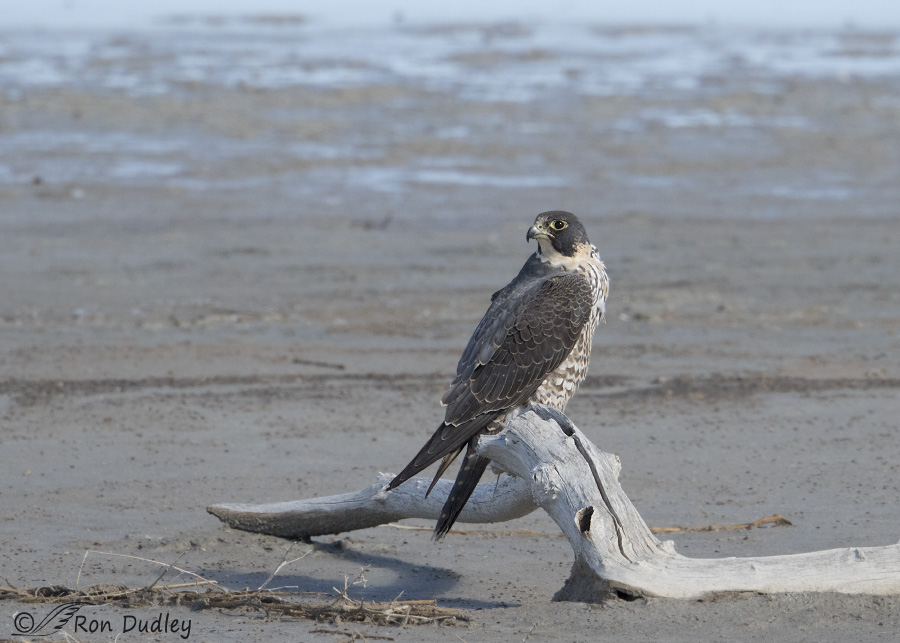
1/2500, f/6.3, ISO 800, Canon 7D Mark II, Canon EF 500mm f/4L IS II USM + 1.4 tc, not baited, set up or called in
I photographed the bird last week as it sort of hopscotched from one bit of scattered prey debris to another along the mudflats of the Great Salt Lake. Here the falcon took a brief break on a slightly elevated driftwood perch.
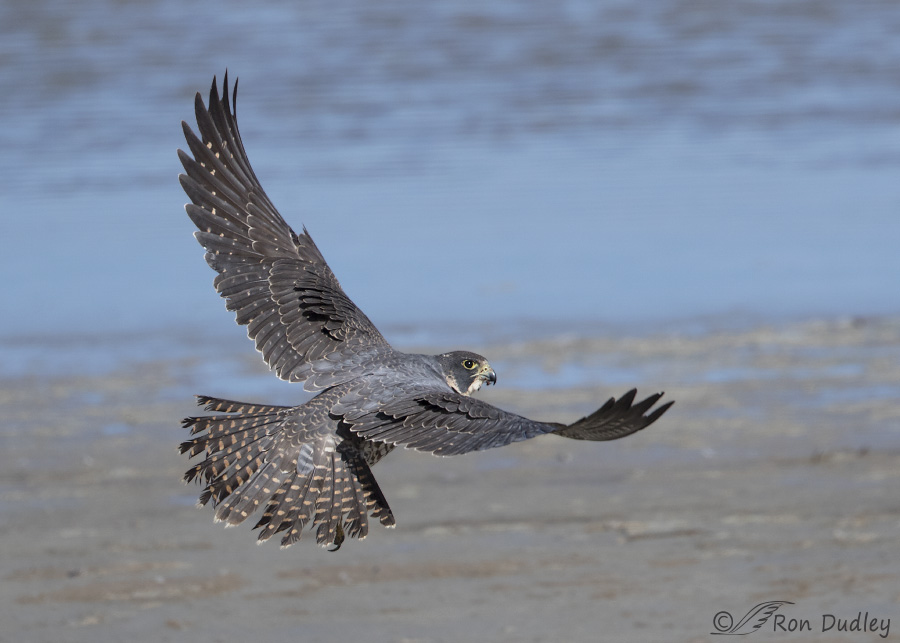
1/4000, f/6.3, ISO 400, Canon 7D Mark II, Canon EF 500mm f/4L IS II USM + 1.4 tc, not baited, set up or called in
I posted this photo of the bird four days ago and suggested that the blue-gray plumage on the back is adult feathers coming in and most knowledgeable readers agreed but in the following comment “Mark” (not Mark Runnels) suggested another possibility – powder down:
- “The grayish tinged, back and nape feathers look peculiar to me and appear more like discolored juvenile feathers than newly replaced adult feathers. If you look closely, you can see that some of the feathers in question still have the juvenile pattern on the surfaces. One possibility, though probably not very likely, is that Peregrines are known to have a grayish “bloom” to their feathers, caused by the presence of “powder-down” feathers that crumble at the tips. These powder-down feathers grow continuously and are never shed. The powder is distributed over the other feathers during preening activities and is thought to make the feathers more water resistant. (Herons also have powder-down feathers). According to Hans Peeters, “Raptors of California”, if you rub a piece of black velvet along the back of an ADULT Peregrine, the material will readily show the gray discoloration from this “bloom”.
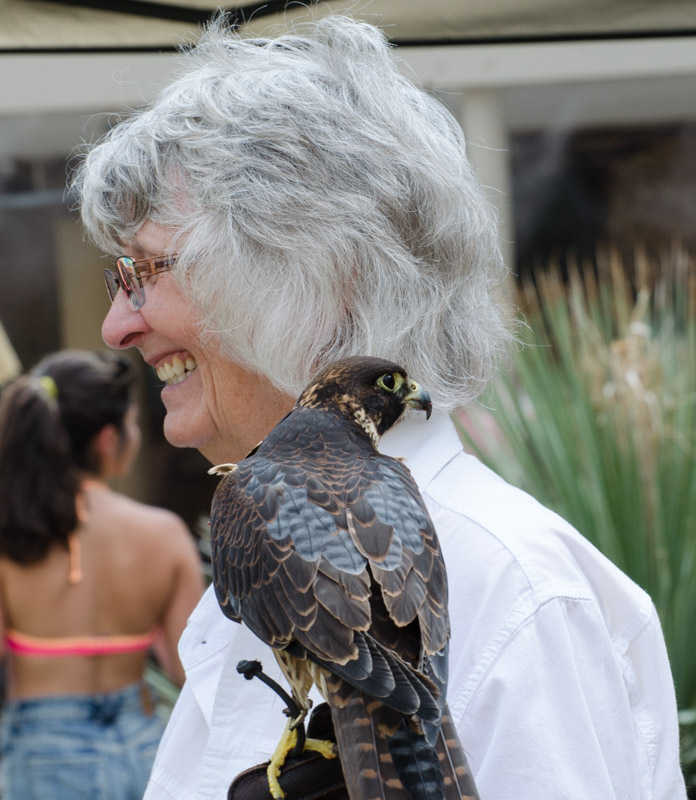
Copyright Dan Weisz/Arizona Desert Museum – Image used by permission
Dan Weisz sent me several photos of this 1 year old male Peregrine (a rehab/education bird) showing new adult blue-gray feathers coming in on his back and elsewhere. I added this photo to the original post but it was done late and most readers didn’t see it. After Mark saw this image he made another interesting comment:
- “Thank you for posting the photo that Dan was kind enough to provide. Something still seems odd about the bird in your photo. On Dan’s photo, the adult feathers are pretty obvious. Besides the blue-gray color, they exhibit a consistent pattern (barring) that is different from the juvenile feathers. I’m not seeing a different pattern on the feathers of the falcon you photographed. Perhaps that’s just due to individual variation, but to my blurry eyes, a good portion of the “adult” feathers still look like discolored juvenile feathers. I wish someone could explain that to me! : )”
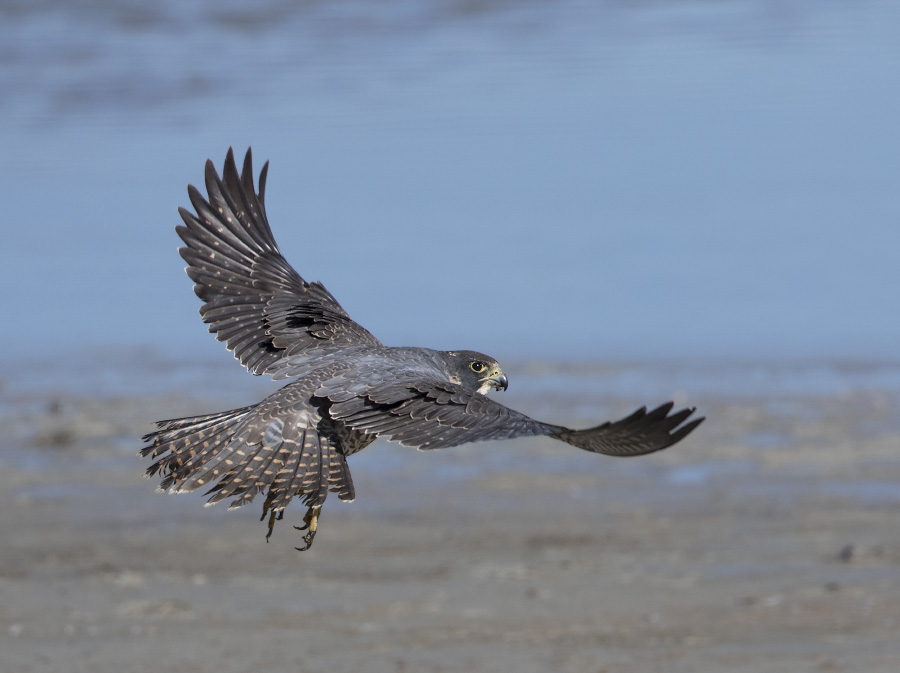
1/3200, f/6.3, ISO 400, Canon 7D Mark II, Canon EF 500mm f/4L IS II USM + 1.4 tc, not baited, set up or called in
So I decided to post some more images of “my” bird that showed those feathers on the back and see if this question can conclusively be cleared up as I’m really quite curious about it.
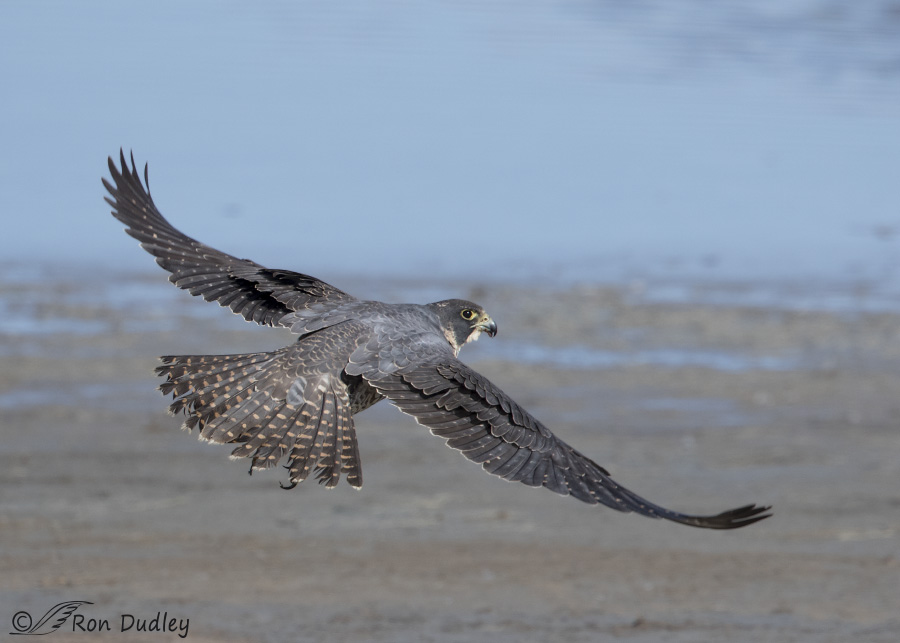
1/2500, f/6.3, ISO 400, Canon 7D Mark II, Canon EF 500mm f/4L IS II USM + 1.4 tc, not baited, set up or called in
Many of these new images are quite similar because when the falcon would take off to land on some more nearby prey debris it always did so into the north wind at almost the same angle.
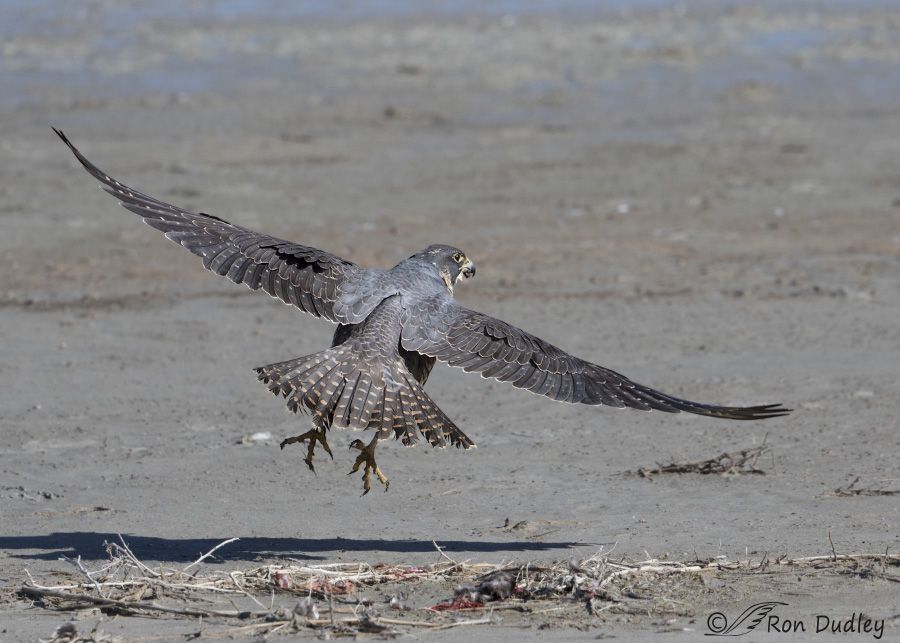
1/3200, f/6.3, ISO 400, Canon 7D Mark II, Canon EF 500mm f/4L IS II USM + 1.4 tc, not baited, set up or called in
But I thought that if I included several of them, one might provide the necessary clue to knowledgeable readers that I don’t have the expertise to interpret.
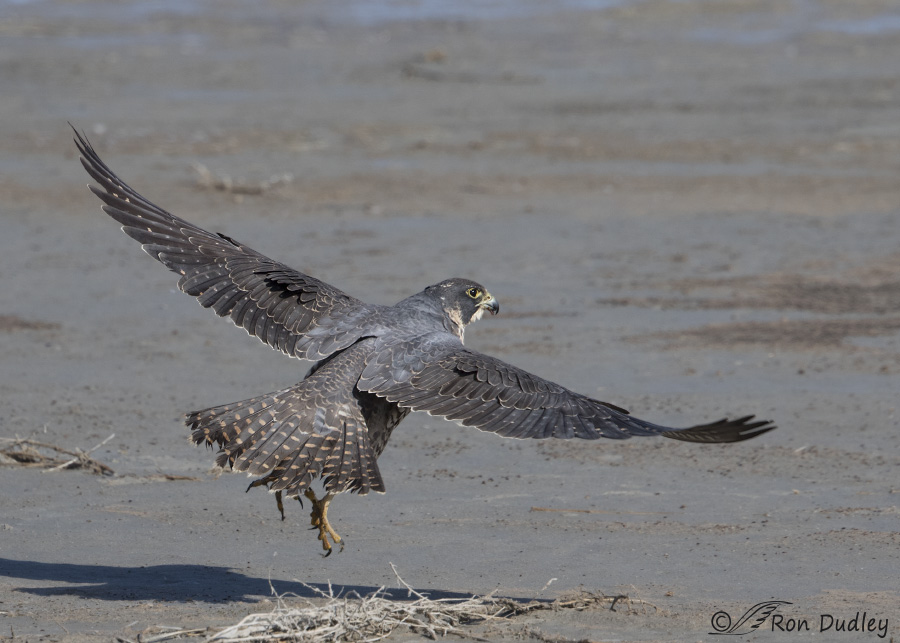
1/2500, f/6.3, ISO 400, Canon 7D Mark II, Canon EF 500mm f/4L IS II USM + 1.4 tc, not baited, set up or called in
Like Mark I’m curious as to why the “new” feathers of this bird don’t show the barring that is so obvious in Dan’s male. That barring is quite apparent in the single new adult uppertail covert of this bird but I don’t see it elsewhere in the new feathers.
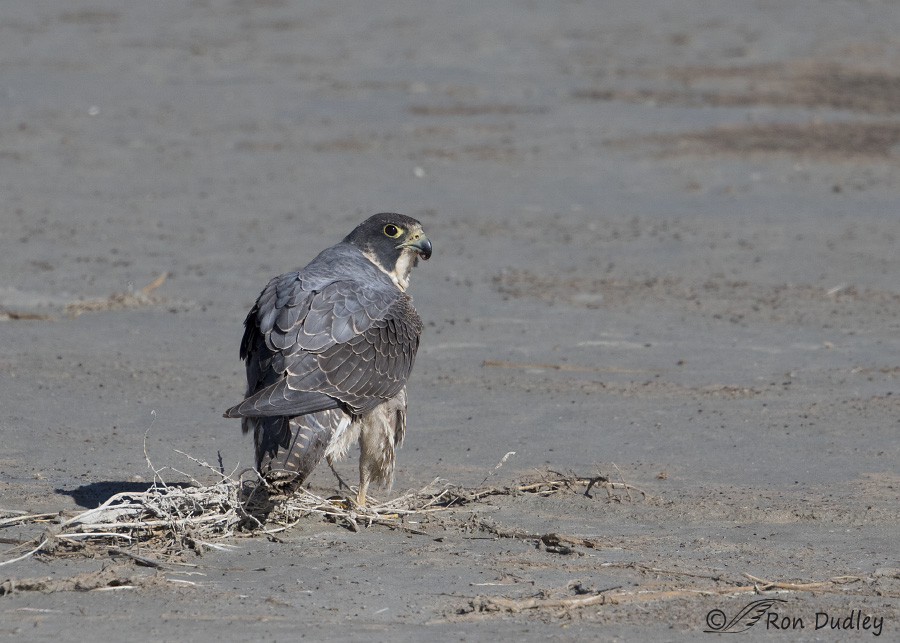
1/3200, f/6.3, ISO 400, Canon 7D Mark II, Canon EF 500mm f/4L IS II USM + 1.4 tc, large crop, not baited, set up or called in
One last look at those feathers from the rear, this time with the wings closed.
I apologize for the esoteric nature of this post. All this is likely too much bird-nerdiness for some of my readers but it has been gnawing at me for a few days so I had to at least make an attempt to satisfy my curiosity. Any and all thoughts on this subject (and others) are welcome.
Ron
Note: I should include another comment Mark made on my previous post about this bird. After doing some research on Hans Peeters I’d have to conclude that his opinion deserves considerable weight.
- “I asked Hans Peeters for his opinion on the grayish feathers. After looking at your photo, he thinks that the grayish color is due to the “bloom” that I described earlier, and that the single upper tail covert is the only adult feather that he can see on the bird.
Isn’t this fun? Hans definitely knows his stuff and being such a gifted artist, he has an amazing eye for detail. It will be interesting to see if your additional photos you post support his opinion.


Most of the feedback I’ve received regarding this question has been off-post, via email.
The consensus seems to be that the plumage differences noted in my post are due to individual variation and that “my” bird is simply a juvenile molting into adult plumage – the implication being that powder down is not a significant factor.
Thanks for your interest and comments everyone!
I’ve looked at about every internet photo of molting Peregrines that I could find, and NONE of them show the grayish, inconsistent coloration like this bird. Also, NONE of them show a nice even “molt” like this bird, in which all the back feathers appear to be neatly in place, with no obvious immature feathers in the mix, and no missing or newly replaced adult flight feathers. None of them. How can that be? If this was supposed to be a quasi-scientific discussion, then I need a little more evidence to support the big bang…err, early molt theory than what’s been given so far. How about a solid explanation, or maybe photos showing similar plumage? How about a transparent, up front discussion, in which contributors are not hiding behind private emails? Is that too much to ask?
Thank you.
Mark, Just to set the record straight I don’t think anyone’s “hiding behind private emails”.
It was simply a matter of a friend of mine asking friends of his to look at the images and let him know what they thought. Then my friend let me know.
I appreciate that they responded at all.
I’m NO expert on peregrines, but I’ve found that overall, just when you think you know something about these birds, they just love to pull the rug out from under you. If it were me, I’d suggest individual diversity, but refer to my first statement. There’s SO much we just don’t know. Otherwise, what a purdy bird 😀
Thanks Laura. Who knows, you may very well be right!
Not nerdy at all.
Driven by curiosity.
And I hope to learn the answer with you to a question I would never have considered without you.
Curiosity can be a nag sometimes, EC. For me it can be either fulfilling or frustrating. Or even both.
Definitely both. Often.
Not being a birder, I’m still enjoying all the information. Since I know nothing about bird feathers, down, powder…..etc. it’s still fun to read about it. Not too much “bird nerd” for me.
Thanks for the beautiful pictures.
“Not too much “bird nerd” for me.”
Good, Carol! Thank you.
Term “powder down” feathers and concept is very interesting and brand new to me…if the Powder” comes from the crumbling tips of special down feathers(which I consider bird underwear), how does it end up on top of outter feathers–especially on shoulders and backs– of the birds who have them, such as some hawks and Great Blue Herons??? What function does it have, if any?
Patty, Mark says that it gets distributed over the feathers during preening and it’s function is waterproofing.
Fantastic! Nature continues to amaze me!!!…
Amazing shots and interesting observations!
Charlotte
Thank you, Charlotte.
I’m not a birder nor photographer but I enjoy the technical aspects you present. I always learn something and that means I start out the day on a high note.
I appreciate that comment, Linda – as evidence that this post isn’t too nerdy for everyone!
Whatever the explanation of the colors on the bird’s back, , I like the way the blue-gray of the bird’s feathers mirror the little “puddlets” of water in what appears to be mud flats….e
Thanks, Patty. Yup, those are the mud flats.
Great shots. I hope the additional photos are enough to resolve the issue.
Thank you, Dave. Me too.
Thank you, Ron, in Dan’s image I’m the old lady holding the the young Prairie falcon. It’s my job (and absolute delight) to tell “stories” about raptors either on the glove or free flying in a demonstration. It is so great to learn new facts for interpretations. Think that parrots have powder down bloom too. When a parrot rouses, you often see the powder in the air. Cool stuff don’t ever stop sharing such carefully researched material. Hooray and thanks again.
Wonderful to “meet” you, Carroll! (though I’d argue about that “old lady” thing…}
Folks like you do a great service for birds and for your audience. Keep up the good work, I applaud you for it.
Whoop, still asleep when I responded. Perhaps I was having Prairie falcon dreams. Raptor in image is definitely a Peregrine. Thanks to Ron for pointing out my gaffe and for wonderful images, stories.
These are all great shots! I wonder if there are plumage variations between eastern and western birds?
Sorry, plumage variation between adult, subadult and immature Peregrine Falcons is not my strong point.
I get excited just seeing one or two, and they don’t give a guy much chance to study them here in the east.
“I wonder if there are plumage variations between eastern and western birds?”
Or between Pacific and Tundra subspecies. Or between sexes (based on comments my bird is likely a female). I just don’t know, Dick.
Very curious…interesting theories…will be interested in how this plays out…..beaitiful bird!
“Very curious”
Me too, Patty. Time will (hopefully) tell…
Nice photo’s, Ron and, interesting biology lesson and ponderings. 🙂
Thanks very much, Judy – on both counts.